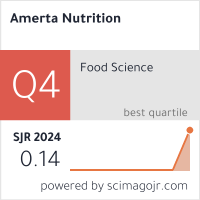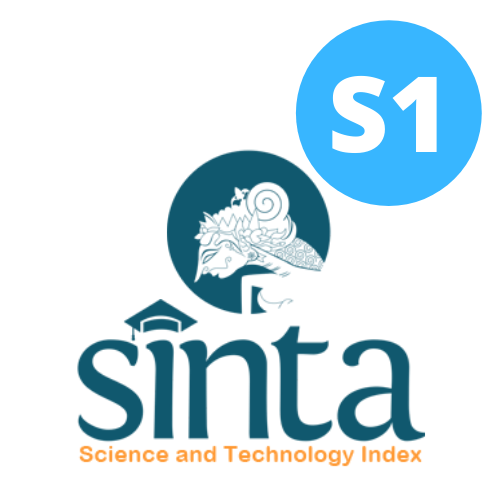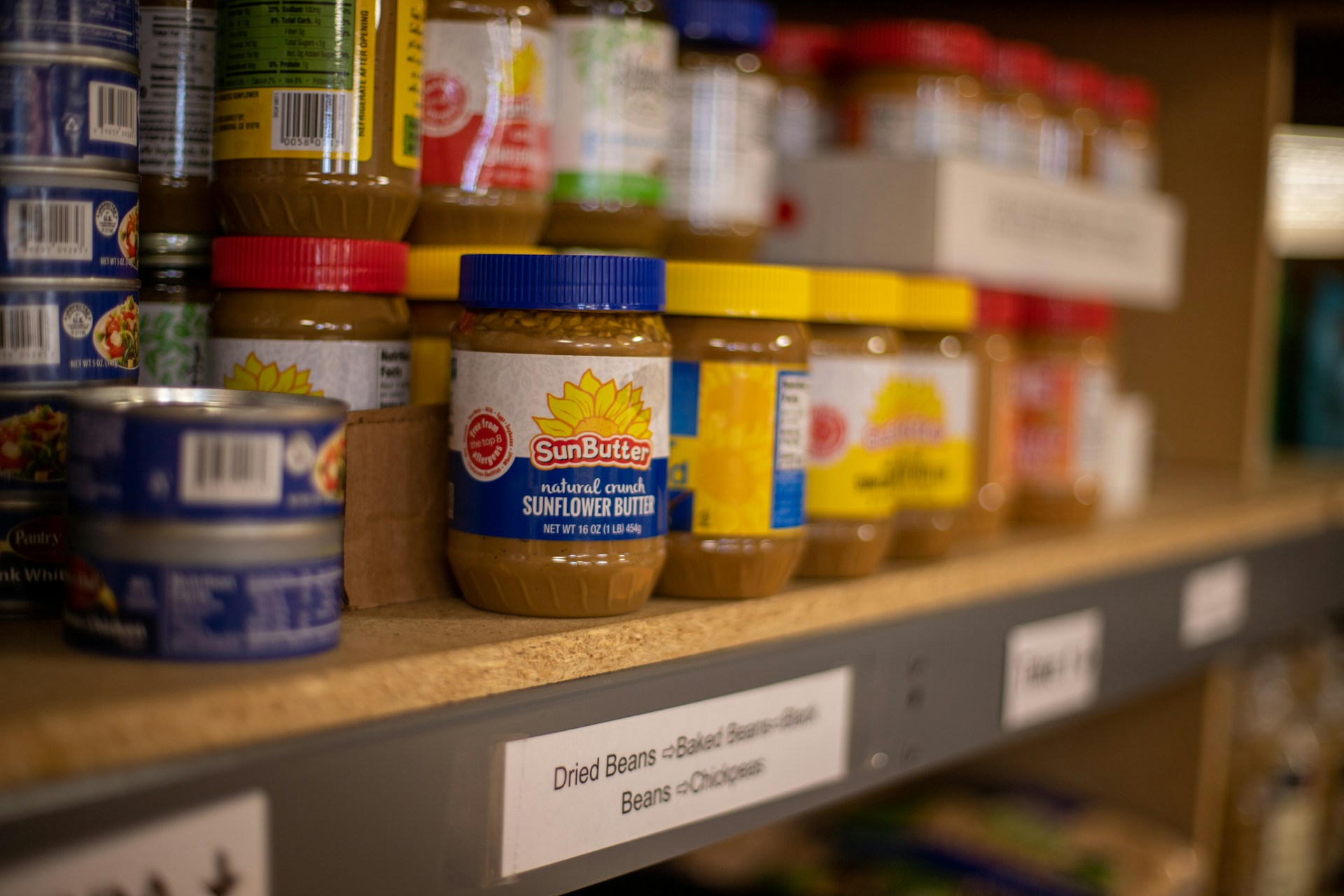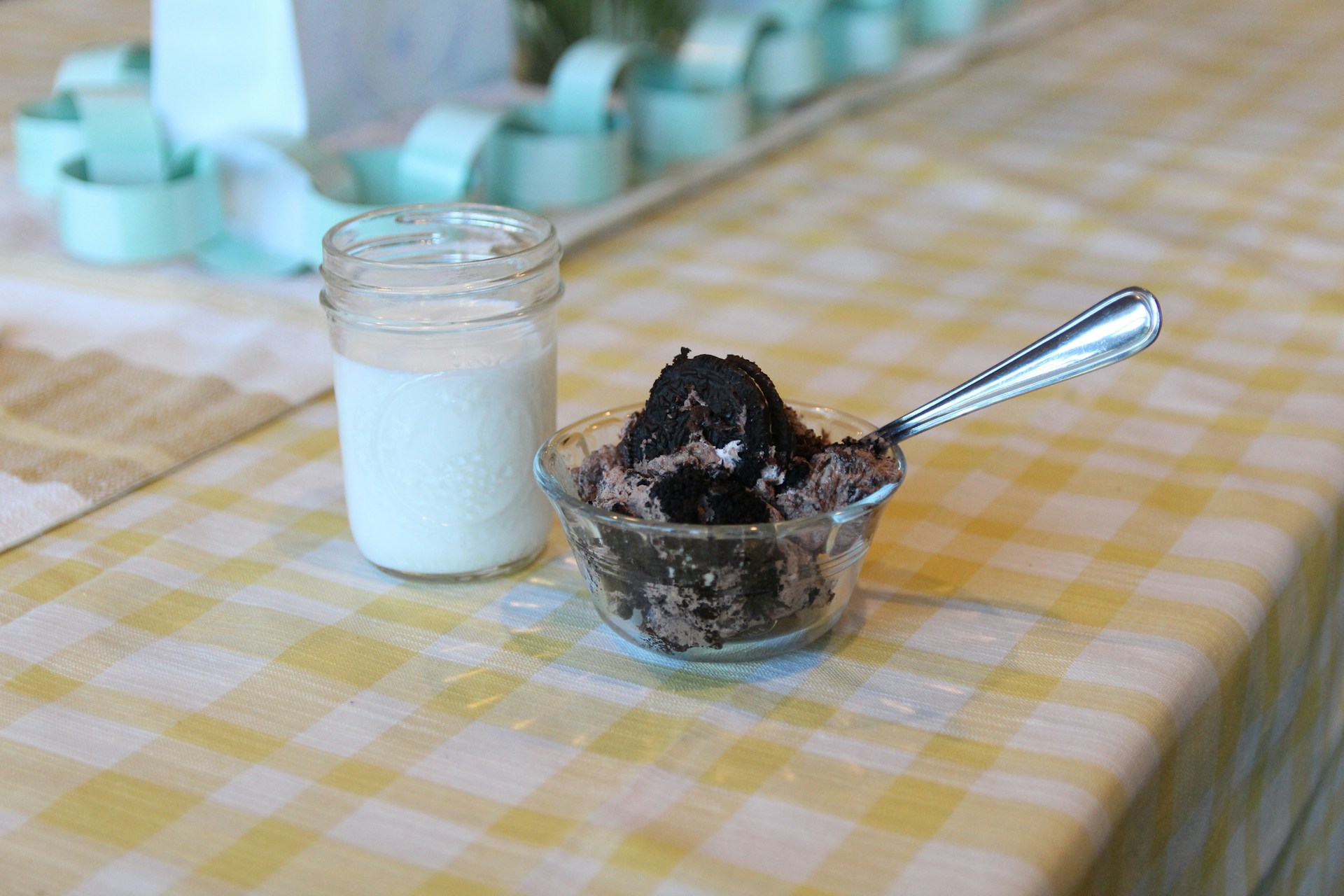The Effect of Sago (Metroxylon sagu Rottb.) Flour and Sorghum (Sorghum bicolor L. Moench) Flour Proportion on Resistant Starch, Nutrient, and Organoleptic Properties of Cookies for Type 2 Diabetes Mellitus
Pengaruh Proporsi Tepung Sagu (Metroxylon sagu Rottb.) dan Tepung Sorgum (Sorghum bicolor L. Moench) terhadap Pati Resistan, Kandungan Gizi, dan Sifat Organoleptik Kukis untuk Diabetes Melitus Tipe 2

Background: Basic Health Research (2018) reported that the prevalence of diabetes mellitus (DM) among individuals aged 15 years and older is 8.5%, with 90–95% of them being type 2 diabetes mellitus (DMT2). Therefore, corrective action through food modification is needed to control blood glucose. Sago and sorghum contain resistant starches that can enhance glycemic and insulin response.
Objectives: To analyse the effect of the proportion of sago flour and sorghum flour on resistant starch, nutritional content, and organoleptic properties of cookies designated for T2DM.
Methods: This study employed a Complete Randomised Design with 5 variations of sago flour and sorghum flour treatment, namely F1 (100%:0%), F2 (75%:25%), F3 (50%:50%), F4 (25%:75%), and F5 (0%:100%), each replicated twice. The analysis of resistant starch and nutritional content utilised a one-way ANOVA test, followed by the Duncan test for significant differences. Organoleptic properties were assessed using the Kruskal Wallis test. The best formulations were determined based on the De Garmo method.
Results: The results revealed significant differences in resistant starch (p-value=0.002), protein (p-value<0.001), carbohydrate (p-value=0.012), and ash content (p-value=0.005). No significant differences were observed in fat (p-value=0.514), moisture content (p-value=0.881), colour (p-value=0.891), aroma (p-value=0.061), texture (p-value=0.164), and taste (p-value=0.421). The F2 formulation emerged as the best, containing 6.31% resistant starch, 7.34% protein, 23.69% fat, 50.95% carbohydrates, 16.19% moisture content, and 1.84% ash content.
Conclusions: The proportion of sago flour and sorghum flour significantly affected the content of resistant starch, protein, carbohydrates, and ash content, but not fat, moisture content, and organoleptic properties.
International Diabetes Federation. IDF Diabetes Atlas 10th Edition. (2021).
Kementerian Kesehatan RI. Laporan Nasional RISKESDAS 2018. (2018).
American Diabetes Association. Classification and diagnosis of diabetes: Standards of Medical Care in Diabetes-2020. Diabetes Care 43, S14–S31 (2020). DOI: https://doi.org/10.2337/dc20-S002
Galicia-Garcia, U. et al. Pathophysiology of Type 2 Diabetes Mellitus. Int J Mol Sci 21, 6275–6308 (2020). DOI: https://doi.org/10.3390/ijms21176275
Murtiningsih, M. K., Pandelaki, K. & Sedli, B. P. Gaya Hidup sebagai Faktor Risiko Diabetes Melitus Tipe 2. Jurnal Ilmiah Kedokteran 15, 328–333 (2021). DOI: https://doi.org/10.35790/ecl.v9i2.32852
Susanti & Bistara, D. N. Hubungan Pola Makan dan Gula Darah Pada Penderita Diabetes Milletus. Jurnal Kesehatan Vokasional 3, 29–34 (2018). DOI: https://doi.org/10.22146/jkesvo.34080
Ashwar, B. A., Gani, A., Shah, A., Wani, I. A. & Masoodi, F. A. Preparation, Health Benefits, and Applications of Resistant Starch-a Review. Starch-Stärke 68, 287–301 (2015). DOI: https://doi.org/10.1002/star.201500064
Li, X. Resistant Starch and Its Applications. Functional Starch and Applications in Foods 63–90 (2018). DOI: https://doi.org/10.1007/978-981-13-1077-5_3
Wang, Y. et al. Effects of the Resistant Starch on Glucose, Insulin, Insulin Resistance, and Lipid Parameters in Overweight or Obese Adults: a Systematic Review and Meta-Analysis. Nutr Diabetes 9, (2019). DOI: https://doi.org/10.1038/s41387-019-0086-9
Tan, F. P. Y., Beltranena, E. & Zijlstra, R. T. Resistant Starch: Implications of Dietary Inclusion on Gut Health and Growth in Pigs: a Review. J Anim Sci Biotechnol 12, 124 (2021). DOI: https://doi.org/10.1186/s40104-021-00644-5
Fitriani, Z. A., Dieny, F. F., Margawati, A. & Jauharany, F. F. Resistant Starch, Amylose, and Amylopectin Content in Breadfruit Cookies as an Alternative Snack for Individuals with Diabetes Mellitus. Food Res 5, 394–400 (2021). DOI: https://doi.org/10.26656/fr.2017.5(1).418
Syartiwidya. Tanaman Sagu sebagai Pangan Sumber Karbohidrat yang Bermanfaat bagi Penderita Diabetes. Jurnal Selodang Mayang 8, 73–82 (2022). DOI: https://doi.org/10.47521/selodangmayang.v8i1.240
Indrastuti, Y. E., Kritandi, A. Y. & Imelda, F. Karakteristik Fisikokimia dan Organoleptik Bubble Pearl Tapioka dan Pati Sagu Lokal Kalimantan Barat. Jurnal Agroindustri 13, 14–23 (2023). DOI: https://doi.org/10.31186/jagroindustri.13.1.14-23
Wahjuningsih, S. B., Haslina & Marsono. Hypolipidaemic Effects of High Resistant Starch Sago and Red Bean Flour- based Analog Rice on Diabetic Rats. Mater Sociomed 30, 232–239 (2018). DOI: https://doi.org/10.5455/msm.2018.30.232-239
Hariyanto, B., Cahyana, P. T., Putranto, A. T., Wahyuningsih, S. B. & Marsono, Y. Penggunaan Beras Sagu untuk Penderita Pradiabetes. Jurnal Pangan 26, 127–136 (2017). DOI: https://doi.org/10.33964/jp.v26i2.361
Wahjuningsih, S. B., Sudjatinah, Azkia, M. N. & Anggraeni, D. The Study of Sorghum (Sorghum bicolor L.), Mung Bean (Vigna radiata) & Sago (Metroxylon sagu) Noodles: Formulation & Physical Characterization. Current Research in Nutrition & Food Science 8, 217–225 (2020). DOI: https://doi.org/10.12944/CRNFSJ.8.1.20
Warsito, H. & Sa’diyah, K. Pembuatan Klepon dengan Substitusi Tepung Sagu sebagai Alternatif Makanan Selingan Indeks Glikemik Rendah. Jurnal Kesehatan 7, 45–57 (2019). DOI: https://doi.org/10.25047/j-kes.v7i1.74
Watumlawar, E. A., Warouw, S. M. & Gunawan, S. Pengaruh Pemberian Sagu dibandingkan Nasi terhadap Berat Badan Tikus Wistar. Jurnal e-Clinic (eCl) 3, 675–678 (2015). DOI: https://doi.org/10.35790/ecl.3.2.2015.8545
Afandi, F. A. Potensi Sumber Karbohidrat Indonesia sebagai Ingridien Pangan Fungsional dengan Kadar Pati Resisten dan Aktivitas Antioksidan Tinggi. J Food Sci Technol 3, 40–57 (2023). DOI: https://doi.org/10.33830/fsj.v3i1.4989.2023
Poquette, N. M., Gu, X. & Lee, S.-O. Grain Sorghum Muffin Reduces Glucose and Insulin Responses in Men. Food Funct 5, 894–899 (2014). DOI: https://doi.org/10.1039/C3FO60432B
Xiong, Y., Zhan, P., Warner, R. D. & Fang, Z. Sorghum Grain: From Genotype, Nutrition, and Phenolic Profile to Its Health Benefits and Food Applications. Compr Rev Food Sci Food Saf 18, 2025–2046 (2019). DOI: https://doi.org/10.1111/1541-4337.12506
Xu, T. Sorghum. Bioactive Factors and Processing Technology for Cereal Foods 103–135 (2019). DOI: https://doi.org/10.1007/978-981-13-6167-8_7
Leboe, D. W., Dhuha, N. S., Wahyuddin, M. & Rutami, N. R. The Potential of Sorghum Bicolor L. as a Blood Glucose Lowering Agent : a Review. Jurnal Kesehatan 1–10 (2020). DOI: https://doi.org/10.24252/kesehatan.v1i1.18181
Rachmawati, L., Mexitalia, M., Muniroh, M., Afifah, D. N. & Pramono, A. Effects of Sorghum Cookies (Sorghum Bicolor L. Moench) on Fasting Glucose, Triglyceride, High-Density Lipoprotein level, and Body Fat Percentage in Adolescent Obesity . Jurnal Gizi Indonesia 10, 181–188 (2022). DOI: https://doi.org/10.14710/jgi.10.2.181-188
Kementerian Pertanian RI. Statistik Konsumsi Pangan Tahun 2020. (2020).
Fernández-Carrión, R. et al. Sweet Taste Preference: Relationships with Other Tastes, Liking for Sugary Foods and Exploratory Genome-Wide Association Analysis in Subjects with Metabolic Syndrome. Biomedicines 10, 79–105 (2021). DOI: https://doi.org/10.3390/biomedicines10010079
Prasetyowati, A. T., Pranata, F. S. & Swasti, Y. R. Kualitas Cookies Substitusi Tepung Sorgum (Sorghum bicolor) dan Tepung Kacang Polong (Pisum Sativum). Jurnal Teknologi Pangan dan Gizi 22, 33–43 (2023). DOI: https://doi.org/10.33508/jtpg.v22i1.4261
Giuberti, G., Gallo, A., Fortunati, P. & Rossi, F. Influence of High-Amylose Maize Starch Addition on in Vitro Starch Digestibility and Sensory Characteristics of Cookies. Starch‐Stärke 68, 469–475 (2016). DOI: https://doi.org/10.1002/star.201500228
Puspita, W., Sulaeman, A. & Damayanthi, E. Snack Bar Berbahan Pati Sagu (Metroxylon sp.), Tempe, dan Beras Hitam sebagai Pangan Fungsional Berindeks Glikemik Rendah. Jurnal Gizi Indonesia 8, 11–23 (2019). DOI: https://doi.org/10.14710/jgi.8.1.11-23
Fathurrizqiah, R. & Panunggal, B. Kandungan Pati Resisten, Amilosa, dan Amilopektin Snack Bar Sorgum sebagai Alternatif Makanan Selingan Bagi Penderita Diabetes Melitus Tipe 2. Journal of Nutrition College 4, 562–569 (2015). DOI: https://doi.org/10.14710/jnc.v4i4.10163
Abd Rashid, R. S., Dos Mohamed, A. M., Achudan, S. N. & Mittis, P. Physicochemical Properties of Resistant Starch Type III from Sago Starch at Different Palm Stages. Mater Today Proc 31, 150–154 (2020). DOI: https://doi.org/10.1016/j.matpr.2020.01.511
Lokman, E. F. et al. Postprandial Glucose-Lowering Effects by Sago (Metroxylon sagu Rottb.) Resistant Starch in Spontaneously Type 2 Diabetes, Goto-Kakizaki Rat. Nutr Health 1–10 (2023). DOI: https://doi.org/10.1177/02601060231152060
Thompson, M. S., Yan, T. H., Saari, N. & Sarbini, S. R. A Review: Resistant Starch, A Promising Prebiotic for Obesity and Weight Management. Food Biosci 50, 101965 (2022). DOI: https://doi.org/10.1016/j.fbio.2022.101965
Nugraheni, M., Hamidah, S. & Auliana, R. A Potential of Coleus Tuberosus Crackers Rich in Resistant Starch Type 3 Improves Glucose and Lipid Profile of Alloxan – Induced Diabetic Mice. Current Research in Nutrition and Food Science 5, 309–319 (2017). DOI: https://doi.org/10.12944/CRNFSJ.5.3.16
Wahjuningsih, S., Marsono, P. D. & Haryanto, B. A Study of Sago Starch and Red Bean Flour-Based Analog Rice Development as Functional Food. International Conference on Agriculture & Food Engineering 71–76 (2016).
Vu, T. H. T. Preparation, Characterization, & Evaluation of Sorghum Flour with Increased Resistant Starch Content. (Kansas State University, 2014).
Wahjuningsih, S. B., Haslina, Nazir, N., Azkia, M. N. & Triputranto, A. Characteristic of Mocaf Noodles with Sago Flour Substitution (Metroxylon sago) and Addition of Latoh (Caulerpa lentillifera). International Journal on Advanced Science Engineering Information Technology 13, 417–422 (2023). DOI: https://doi.org/10.18517/ijaseit.13.2.18205
Birt, D. F. et al. Resistant Starch: Promise for Improving Human Health. Advances in Nutrition 4, 587–601 (2013). DOI: https://doi.org/10.3945/an.113.004325
Wang, S., Li, C., Copeland, L., Niu, Q. & Wang, S. Starch Retrogradation: A Comprehensive Review. Compr Rev Food Sci Food Saf 14, 568–585 (2015). DOI: https://doi.org/10.1111/1541-4337.12143
Purbowati & Anugrah, R. M. Pengaruh Suhu dan Lama Penyimpanan terhadap Kadar Glukosa pada Nasi Putih. Nutri-Sains: Jurnal Gizi Pangan dan Aplikasinya 4, 15–24 (2020). DOI: https://doi.org/10.21580/ns.2020.4.1.4565
Kohanmoo, A., Faghih, S. & Akhlaghi, M. Effect of Short- and Long-Term Protein Consumption on Appetite and Appetite Regulating Gastrointestinal Hormones, A Systematic Review and Meta-Analysis of Randomized Controlled Trials. Physiol Behav 226, 113123–113132 (2020). DOI: https://doi.org/10.1016/j.physbeh.2020.113123
USDA. Food Data Central. United States Department of Agriculture https://fdc.nal.usda.gov/fdc-app.html#/food-details/168943/nutrients (2019).
Caesy, C. P., Sitania, C. K., Gunawan, S. & Aparamarta, H. W. Pengolahan Tepung Sagu dengan Fermentasi Aerobik Menggunakan Rhizopus sp. Jurnal Teknik ITS 7, 132–134 (2018). DOI: https://doi.org/10.12962/j23373539.v7i1.28811
Adeyeye, S. A. O. Assessment of Quality and Sensory Properties of Sorghum–Wheat Flour Cookies. Cogent Food Agric 2, 1–10 (2016). DOI: https://doi.org/10.1080/23311932.2016.1245059
N. F., A. N. R., Hartati, F. K. & Hariyani, N. Chemical and Organoleptic Quality of Free-Gluten Dry Noodles from Sorghum (Sorghum bicolor) and Modified Cassava Flour with Different Drying Temperature. Journal of Technology and Information System 1, 64–71 (2023). DOI: https://doi.org/10.58905/saga.v1i3.69
Rimbawan & Nurbayani, R. Nilai Indeks Glikemik Produk Olahan Gembili. Jurnal Gizi dan Pangan 8, 145–150 (2013). DOI: https://doi.org/10.25182/jgp.2013.8.2.145-150
Arif, A., Budiyanto, A. & Hoerudin. Glicemic Index of Foods and Its Affecting Factors. Jurnal Litbang Pertanian 32, 91–99 (2013).
Yuwono, S. S., Waziiroh, E. & Putri, W. D. R. Teknologi Pengolahan Pangan Hasil Perkebunan. (Universitas Brawijaya Press, Malang, 2017).
Alhadi, F., Fitri, C. A. & AB, A. Pengaruh Penggunaan Tepung Sagu Aren terhadap Kadar Protein, pH, Kadar Karbohidrat Patty Burger Daging Sapi. Jurnal Ilmiah Mahasiswa Pertanian 8, 385–392 (2023). DOI: https://doi.org/10.17969/jimfp.v8i4.28006
Rahman, N. & Naiu, A. S. Karakteristik Kukis Bagea Tepung Sagu (Metroxylon sp.) yang Disubstitusi Tepung Ikan Teri (Stolephorus indicus). Jambura Fish Processing Journal 3, 16–26 (2021). DOI: https://doi.org/10.37905/jfpj.v3i1.7779
Surahman, D. N. et al. Pendugaan Umur Simpan Snack Bar Pisang dengan Metode Arrhenius pada Suhu Penyimpanan yang Berbeda. Biopropal Industri 11, 127–137 (2020). DOI: https://doi.org/10.36974/jbi.v11i2.5898
Zulfatunna’im, L. D., Bintari, S. H., Mubarok, I. & Dewi, P. Potensi Ekstrak Akuades Biji Pepaya sebagai Penghambat Pertumbuhan Khamir Penyebab Busuk Buah Tomat dan Stroberi. Life Science 11, 13–28 (2022). DOI: https://doi.org/10.15294/lifesci.v11i1.59788
Mandasari, R., Amanto, B. S. & A. Achmad Ridwan. Kajian Karakteristik Fisik, Kimia, Fisikokimia, dan Sensori Tepung Kentang Hitam (Coleus tuberosus) Termodifikasi Menggunakan Asam Laktat. Jurnal Teknosains Pangan 4, 1–15 (2015).
Fatkurahman, R., Windi, A. & Basito. Karakteristik Sensoris dan Sifat Fisikokimia Cookies dengan Subtitusi Bekatul Beras Hitam (Oryza sativa L.) dan Tepung Jagung (Zea mays L.). Jurnal Teknosains Pangan 1, 49–57 (2012).
Polii, F. F. Pengaruh Substitusi Tepung Kelapa terhadap Kandungan Gizi dan Sifat Organoleptik Kue Kering. Buletin Palma 18, 91–98 (2017). DOI: https://doi.org/10.21082/bp.v18n2.2017.91-98
Fitria, E., Hariyadi, P., Andarwulan, N. & Triana, R. N. Sifat Fisikokimia Pati Sagu Termodifikasi dengan Metode Oksidasi Menggunakan Natrium Hipoklorit. Jurnal Mutu Pangan 5, 100–108 (2018).
Wulandari, E., Sukarminah, E., Mardawati, E. & Furi, H. L. Profil Gelatinisasi Tepung Sorgum Putih Termodifikasi α-Amilase. Jurnal Teknologi dan Industri Pangan 30, 173–179 (2019). DOI: https://doi.org/10.6066/jtip.2019.30.2.173
Kustiningsih, H. & Retnawati, D. W. Pengaruh Penambahan Daun Indigofera Segar terhadap Produksi dan Warna Kuning Telur (Yolk) Ayam Petelur Kampung Unggul Balitbangtan. Jurnal Pengembangan Penyuluhan Pertanian 17, 241–251 (2020). DOI: https://doi.org/10.36626/jppp.v17i32.561
Haryani, K., Hargono, Handayani, N. A., Ramadani, P. & Rezekia, D. Substitusi Terigu dengan Pati Sorgum Terfermentasi pada Pembuatan Roti Tawar: Studi Suhu Pemanggangan. Jurnal Aplikasi Teknologi Pangan 6, 61–64 (2017). DOI: https://doi.org/10.17728/jatp.197
Tarwendah, I. P. Jurnal Review: Studi Komparasi Atribut Sensoris dan Kesadaran Merek Produk Pangan. Jurnal Pangan dan Agroindustri 5, 66–73 (2017).
Rading, Y. V., Mushollaeni, W. & Wirawan. Pembuatan Egg Roll dari Tepung Labu Kuning (Cucurbita Muschata Durch) Modifikasi sebagai Pengganti Tepung Terigu. Jurnal Riset Multidisiplin dan Inovasi Teknologi 2, 86–100 (2024). DOI: https://doi.org/10.59653/jimat.v2i01.350
Budiyanto, A., Arif, A. B. & Richana, N. Optimization of Liquid Sugar Production Process from Sago (Metroxylon spp.). IOP Conf Ser Earth Environ Sci 309, (2019). DOI: https://doi.org/10.1088/1755-1315/309/1/012052
Riyanto, W., Alsuhendra & Mahdiyah. Pengaruh Substitusi Tepung Sorgum Putih pada Pembuatan Fig Bar terhadap Daya Terima Konsumen. Jurnal Teknologi Busana dan Boga 8, 108–113 (2020). DOI: https://doi.org/10.15294/teknobuga.v8i2.23284
Hasnelly & Ghaffar, R. M. Uji Organoleptik Mi Lidi Berbasis Jewawut dan Beras Merah sebagai Alternatif Camilan Bebas Gluten. Pasundan Food Technology Journal 8, 85–88 (2021). DOI: https://doi.org/10.23969/pftj.v8i3.4448
Sitanggang, A. B. Faktor Kerusakan Produk Bakeri dan Pengendaliannya. Food Review Indonesia 12, 40–44 (2017).
Nusa, M. I., MD, M. & Hakim, F. A. Identifikasi Mutu Fisik Kimia dan Organoleptik Penambahan Ekstrak Jahe (Zingiber officinale) pada Pembuatan Es Krim Sari Kacang Hijau (Phaseolus radiatus L.). Jurnal Teknologi Pangan dan Hasil Pertanian 2, 47–51 (2019). DOI: https://doi.org/10.30596/agrintech.v2i2.3433
Copyright (c) 2025 Amerta Nutrition

This work is licensed under a Creative Commons Attribution-ShareAlike 4.0 International License.
AMERTA NUTR by Unair is licensed under a Creative Commons Attribution-ShareAlike 4.0 International License.
1. The journal allows the author to hold the copyright of the article without restrictions.
2. The journal allows the author(s) to retain publishing rights without restrictions
3. The legal formal aspect of journal publication accessibility refers to Creative Commons Attribution Share-Alike (CC BY-SA).
4. The Creative Commons Attribution Share-Alike (CC BY-SA) license allows re-distribution and re-use of a licensed work on the conditions that the creator is appropriately credited and that any derivative work is made available under "the same, similar or a compatible license”. Other than the conditions mentioned above, the editorial board is not responsible for copyright violation.












































